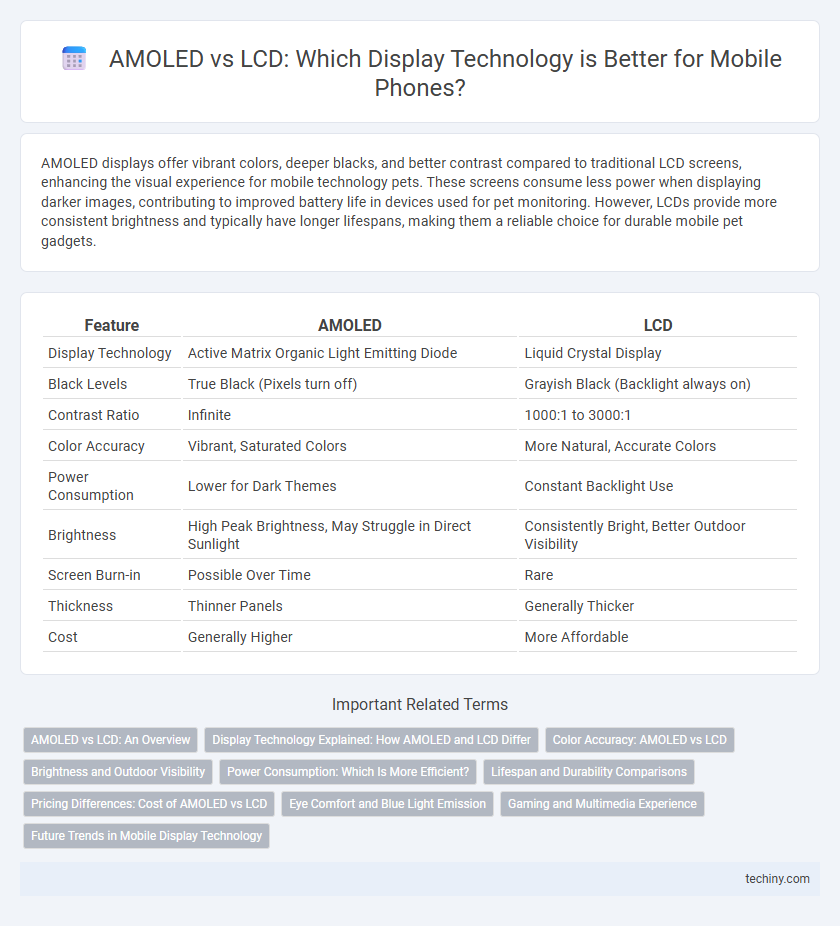AMOLED displays offer vibrant colors, deeper blacks, and better contrast compared to traditional LCD screens, enhancing the visual experience for mobile technology pets. These screens consume less power when displaying darker images, contributing to improved battery life in devices used for pet monitoring. However, LCDs provide more consistent brightness and typically have longer lifespans, making them a reliable choice for durable mobile pet gadgets.
Table of Comparison
| Feature | AMOLED | LCD |
|---|---|---|
| Display Technology | Active Matrix Organic Light Emitting Diode | Liquid Crystal Display |
| Black Levels | True Black (Pixels turn off) | Grayish Black (Backlight always on) |
| Contrast Ratio | Infinite | 1000:1 to 3000:1 |
| Color Accuracy | Vibrant, Saturated Colors | More Natural, Accurate Colors |
| Power Consumption | Lower for Dark Themes | Constant Backlight Use |
| Brightness | High Peak Brightness, May Struggle in Direct Sunlight | Consistently Bright, Better Outdoor Visibility |
| Screen Burn-in | Possible Over Time | Rare |
| Thickness | Thinner Panels | Generally Thicker |
| Cost | Generally Higher | More Affordable |
AMOLED vs LCD: An Overview
AMOLED displays offer superior contrast ratios, deeper blacks, and more vibrant colors compared to LCD screens, making them ideal for mobile devices with high dynamic range requirements. Unlike LCDs, which rely on backlighting, AMOLED pixels emit their own light, resulting in better energy efficiency, especially when displaying dark themes. Despite higher manufacturing costs, AMOLED technology enhances user experience with faster response times and wider viewing angles in smartphones and tablets.
Display Technology Explained: How AMOLED and LCD Differ
AMOLED and LCD differ primarily in their pixel illumination methods, with AMOLED using organic compounds that emit light individually, allowing for deeper blacks and higher contrast ratios, while LCD relies on a backlight shining through liquid crystals, resulting in less dynamic contrast. AMOLED displays offer faster refresh rates and better energy efficiency when displaying darker images, making them ideal for smartphones requiring vivid visuals and battery optimization. In contrast, LCDs tend to perform better under direct sunlight due to their higher brightness levels, though they often consume more power overall compared to AMOLED technology.
Color Accuracy: AMOLED vs LCD
AMOLED displays offer superior color accuracy with deeper blacks and higher contrast ratios due to their individually lit pixels, resulting in more vibrant and true-to-life colors compared to LCDs. LCD screens rely on a backlight that can cause light bleed and less precise color reproduction, especially in dark scenes. This makes AMOLED the preferred choice for users prioritizing rich color depth and more accurate visual representation in mobile technology.
Brightness and Outdoor Visibility
AMOLED displays offer deeper blacks and higher contrast ratios, enhancing visibility in direct sunlight despite generally lower peak brightness than LCDs. LCD screens typically achieve higher maximum brightness levels, improving outdoor readability in bright environments but with less vivid color reproduction. For optimal outdoor visibility, AMOLED technology balances power efficiency with superior contrast, while LCDs rely on intense backlighting to maintain clarity under bright conditions.
Power Consumption: Which Is More Efficient?
AMOLED displays consume less power than LCDs by illuminating individual pixels, which allows for true blacks and reduced energy usage in dark scenes. LCDs rely on a constant backlight, leading to higher power consumption regardless of image brightness. Devices with predominantly dark interfaces or themes benefit significantly from AMOLED technology in extending battery life.
Lifespan and Durability Comparisons
AMOLED displays generally have a shorter lifespan compared to LCDs due to organic materials that degrade over time, typically lasting around 20,000 to 30,000 hours before noticeable dimming occurs. LCDs, which use inorganic backlighting like LEDs, tend to offer longer durability, often exceeding 50,000 hours without significant quality loss. However, AMOLED screens provide better resistance to physical impacts and thinner designs, though they are more susceptible to screen burn-in and color fading with prolonged use.
Pricing Differences: Cost of AMOLED vs LCD
AMOLED displays generally cost more to manufacture than LCDs due to their complex organic light-emitting diode technology and higher production yields. LCD panels use backlighting and simpler manufacturing processes, making them more affordable for mass-market devices. Pricing differences significantly impact smartphone costs, with AMOLED often reserved for premium models offering superior contrast and color quality.
Eye Comfort and Blue Light Emission
AMOLED displays generally offer better eye comfort compared to LCDs due to their ability to individually turn off pixels, resulting in deeper blacks and reduced screen glare. Studies show AMOLED panels emit significantly lower levels of blue light, which minimizes eye strain and disruption to circadian rhythms. LCD screens, relying on backlighting, tend to emit higher blue light levels, often necessitating software-based blue light filters to mitigate discomfort during prolonged use.
Gaming and Multimedia Experience
AMOLED displays provide superior contrast ratios and deeper blacks compared to LCDs, enhancing visual immersion in gaming and multimedia applications. Faster pixel response times in AMOLED technology reduce motion blur, crucial for high-speed gaming sequences and dynamic video playback. While LCDs often deliver higher brightness levels, AMOLED's vibrant color accuracy and energy efficiency make it the preferred choice for prolonged mobile gaming and media consumption.
Future Trends in Mobile Display Technology
AMOLED displays continue to advance with higher resolution, improved energy efficiency, and flexible screen technology, driving the future of immersive mobile experiences. LCD technology remains relevant for cost-effective devices but faces growing competition from OLED innovations in brightness and color accuracy. Emerging microLED technology promises to blend the best of AMOLED and LCD, heralding a new era of durable, vibrant, and power-efficient mobile displays.
AMOLED vs LCD Infographic

 techiny.com
techiny.com